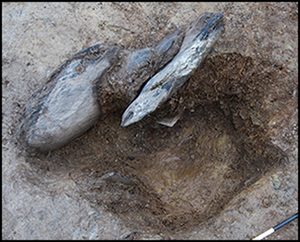Crossref Citations
This article has been cited by the following publications. This list is generated based on data provided by
Crossref.
Bevins, Richard E.
Pearce, Nick J.G.
and
Ixer, Rob A.
2021.
Revisiting the provenance of the Stonehenge bluestones: Refining the provenance of the Group 2 non-spotted dolerites using rare earth element geochemistry.
Journal of Archaeological Science: Reports,
Vol. 38,
Issue. ,
p.
103083.
Savatier, François
2021.
Stonehenge : des mégalithes vagabonds.
Pour la Science,
Vol. N° 522 - avril,
Issue. 4,
p.
9b.
Antonson, Hans
Buckland, Philip
and
Blomqvist, Göran
2021.
Road Salt Damage to Historical Milestones Indicates Adaptation of Winter Roads to Future Climate Change May Damage Arctic Cultural Heritage.
Climate,
Vol. 9,
Issue. 10,
p.
149.
Fowler, Chris
2021.
Petrification Processes in Matter and Society.
p.
81.
Darvill, Timothy
2022.
Mythical rings? Waun Mawn and Stonehenge Stage 1.
Antiquity,
Vol. 96,
Issue. 390,
p.
1515.
Pearce, Nick J.G.
Bevins, Richard E.
and
Ixer, Rob A.
2022.
Portable XRF investigation of Stonehenge Stone 62 and potential source dolerite outcrops in the Mynydd Preseli, west Wales.
Journal of Archaeological Science: Reports,
Vol. 44,
Issue. ,
p.
103525.
Parker Pearson, Mike
Pollard, Josh
Richards, Colin
Welham, Kate
Kinnaird, Timothy
Srivastava, Aayush
Casswell, Chris
Shaw, Dave
Simmons, Ellen
Stanford, Adam
Bevins, Richard
Ixer, Rob
Ruggles, Clive
Rylatt, Jim
and
Edinborough, Kevan
2022.
How Waun Mawn stone circle was designed and built, and when the Bluestones arrived at Stonehenge: a response to Darvill.
Antiquity,
Vol. 96,
Issue. 390,
p.
1530.
Bevins, Richard E.
Pearce, Nick J.G.
Pearson, Mike Parker
and
Ixer, Rob A.
2022.
Identification of the source of dolerites used at the Waun Mawn stone circle in the Mynydd Preseli, west Wales and implications for the proposed link with Stonehenge.
Journal of Archaeological Science: Reports,
Vol. 45,
Issue. ,
p.
103556.
García Sanjuán, Leonardo
Medialdea, Alicia
Balsera Nieto, Verónica
Athanassas, Constantin
Pike, Alistair
Standish, Christopher D.
Dias, Maria Isabel
Rodrigues, Ana Luisa
Clavero Toledo, José Luis
Wheatley, David W.
and
Cintas-Peña, Marta
2023.
A multimethod approach to the genesis of Menga, a World Heritage megalith.
Quaternary Research,
Vol. 111,
Issue. ,
p.
1.
Pousset, Raimund
2023.
Senizid.
p.
131.
Parker Pearson, Mike
2023.
Encyclopedia of Geoarchaeology.
p.
1.
Ruggles, Clive
and
Chadburn, Amanda
2024.
Missing data.
Cosmovisiones / Cosmovisões,
Vol. 5,
Issue. 1,
p.
99.
Bradley, Richard
2024.
Beyond the bluestones: links between distant monuments in Late Neolithic Britain and Ireland.
Antiquity,
Vol. 98,
Issue. 399,
p.
821.
John, Brian
2024.
The Stonehenge bluestones did not come from Waun Mawn in West Wales.
The Holocene,
Vol. 34,
Issue. 7,
p.
895.
Magli, Giulio
2024.
Archaeoastronomy.
p.
127.
John, Brian Stephen
2024.
A bluestone boulder at Stonehenge: implications for the glacial transport theory.
E&G Quaternary Science Journal,
Vol. 73,
Issue. 1,
p.
117.
Bevins, Richard E.
Pearce, Nick J.G.
Hillier, Stephen
Pirrie, Duncan
Ixer, Rob A.
Andò, Sergio
Barbarano, Marta
Power, Matthew
and
Turner, Peter
2024.
Was the Stonehenge Altar Stone from Orkney? Investigating the mineralogy and geochemistry of Orcadian Old Red sandstones and Neolithic circle monuments.
Journal of Archaeological Science: Reports,
Vol. 58,
Issue. ,
p.
104738.
Hines, John
2025.
Anglo-Saxon Stonehenge.
Early Medieval England and its Neighbours,
Vol. 51,
Issue. ,
Bevins, Richard E.
Pearce, Nick J.G.
Ixer, Rob A.
Scourse, James
Daw, Tim
Pearson, Mike Parker
Pitts, Mike
Field, David
Pirrie, Duncan
Saunders, Ian
and
Power, Matthew
2025.
The enigmatic ‘Newall boulder’ excavated at Stonehenge in 1924: New data and correcting the record.
Journal of Archaeological Science: Reports,
Vol. 66,
Issue. ,
p.
105303.
Wilton, Oliver
Barnett Howland, Matthew
and
Parker, Thomas
2025.
Nested stone pasts and futures: stone reuse prototyping at St Leonard’s Hill.
Architecture, Structures and Construction,
Vol. 5,
Issue. 1,
